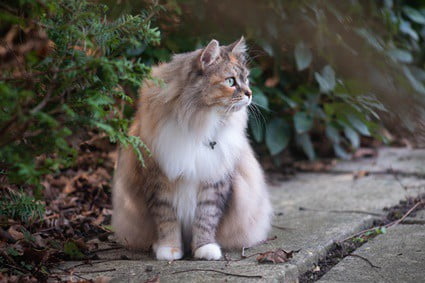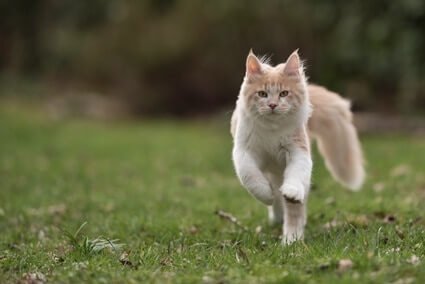Cats move their tails instinctively. Cats’ tails can bend, rotate, and even curl on command. However, these dexterous appendages may seem stiff at times. That can make it seem like cats don’t have control over their tails. After all, if they did, they would surely use them in more creative ways.
Cats control their tails voluntarily. From the base to the tip, a cat’s tail is a series of complex muscles, nerves, tendons, ligaments, and bones. This gives a cat full control over all its movements, feelings, and positions. Cats use this to improve their balance, enhance their landings, help them run faster, and express emotions. Just like any body part, it can be susceptible to reflexes and involuntary movements.
For example, sleeping cats may flick their tails without meaning to. If the cat is injured or sick, its tail may be less responsive and more prone to involuntary twitches. Cats aren’t able to use their tails like monkeys. Cats have 23 vertebrae in their tails, 6 muscles, and various ligaments. However, it’s insufficient to use the tail as a fifth limb.
Do Cats Have Control Over The Movement Of Their Tails?
While reflexes occasionally take over, most cats have complete control over their tails. This is especially true when they’re awake and alert.
That’s because the tail is full of countless nerves and receptors. These are connected to the spine, nervous system, and brain. Just like your cat can command its legs to move, it can force its tail to wag or curl.
Are Cats In Control Of Their Tails?
A cat’s tail may appear soft and flexible. If your cat has long hair and a fluffy coat, it may even seem like the tail has no substance to it at all. However, you can rest assured that the cat is fully aware of its tail, all the sensations it touches, and how it moves.
That’s why many cats will yowl or hiss when you accidentally step on their tail. If you happen to tug on your cat’s tail and it doesn’t react, it’s likely being patient with you.
Rare exceptions are when a cat has a tail injury or nerve damage. In these cases, they may no longer have any feeling in their tails and cannot control them. If your cat’s tail is permanently cocked in an odd direction or doesn’t appear to move often, this may be the case.
How Do Cats Control Their Tails?
Cats manage their tail movement through a variety of muscles, nerves, bones, and tendons. On a microscopic level, this is a complex system that researchers are still coming to understand. For your cat, however, it’s second nature. Cats don’t need to learn how to operate their tails. Just like walking, it’s something that comes naturally with age.
The tail of a cat is directly connected to the spine through a series of vertebrae, ligaments, and tendons. It contains up to 10% of the animal’s bone mass. According to the Department of Veterinary Physiology, cats have 6 distinct muscles in their tail. These are individually used to shift, twitch, and wag the tail as the cat pleases. The reflexes and micro-reactions are carried out with the use of the cat’s nervous system.
When a cat’s tail makes contact with an object or even feels temperature changes in the air, its nerve receptors intake this data. This data is then transmitted through the nervous system, up the spine, and to the brain. Here, the cat’s neural co-processors compute that information and allow the cat to react accordingly.
This takes place within a fraction of a second. As such, your cat may react negatively to having its tail stepped on, or it may turn around to lean into an affectionate touch. This is the result of many lightning-fast signals traveling through your cat from all points of its body – tail included – and to its brain. It’s no different than how it will move its legs or the rest of its body.
How Much Control Do Cats Have Over Their Tails?
Cats have control over their entire tails. While many believe that the very tips of a cat’s tail are immune to feeling or control, this isn’t the case. Instead, cats will even flick the end of their tail without trouble.
This misconception primarily comes from long-haired cats. The tips of their tails may actually be hair, not the flesh-and-bone tip. Cats do not control their hair and only have command over their muscles, tendons, and ligaments.
With that said, cats don’t have full control over their tails when asleep. Like the rest of their body, the tail should remain immobile while they’re resting. This only changes if involuntary reflexes are triggered while they’re sleeping. For example, the cat may be dreaming, or it may have started to wake up, twitching its tail and ears as it did.
Do Cats Move Their Tails Voluntarily?
Cats use their tails voluntarily when awake, but they can also move involuntarily when asleep. Depending on the current situation, your cat will move its tail slowly or rapidly in various directions and positions. Here are some examples:
Voluntary Movements
Voluntary tail movements normally occur when the cat is awake and conscious about its environment. These motions happen intentionally rather than as a reflex. Cats purposefully move their tails in order to:
Retain Balance
Tails work as a counterbalance for felines. If your cat’s weight shifts left, for example, the tail may swing or even rotate in the other direction. This throws a portion of its weight in that direction so that the cat doesn’t tip over.
This is especially vital if the cat is falling, trying to balance on a narrow walkway, or trying to stick a landing. In fact, that is to thank for why cats always land on their feet. If your cat tumbles with its back facing the ground, it can swing its tail, rotate its body around, and land on its dexterous legs.
Improving Speed
In particular, rotating a tail allows cats to realign their hips and legs. This would take more time and muscle control if the cat didn’t have a tail.
In larger cat species, such as with cheetahs, the tail is used to make these apex predators even faster. They can corner with impressive accuracy, using their tail to spin wildly and keep them from tumbling over.

Express Body Language
Cats use their tails to communicate with dogs, humans, and their fellow cats. For example, a cat will wag its tail when:
- Happy
- Excited
- Playful
- Angry
- Defensive
Cats also use their tails to ward off other cats or to attract potential mates. After all, adult felines do not meow at each other. Instead, they rely on small twitches and motions with their tail to communicate feelings or intentions.
Involuntary Movements
Involuntary tail movements happen in cats when they’re asleep or inactive. Since their appendage is still intricately connected with their nervous system and spine, it may act out of reflex. It’s no different than your cat’s leg or ear twitching.
REM (Dreaming)
Cats dream just like people and may act out in their sleep. If the cat is within the REM cycle, it may dream of hunting, stalking, or playing with toys. As a natural reaction, its legs, ears, or tail may flick and twitch in response to what plays out behind its eyelids. If your cat is a particularly deep sleeper, it may even puff up its tail or curl it upwards.
Injury
The tail of a cat is connected directly to the spine. This means that some types of injury lead to serious issues along the back of your feline, according to Veterinary Surgery. The injured nerves will cause muscle spasms, and as a result, your cat will wag its tail involuntarily.
Environmental Reaction
Your cat’s tail might twitch and move due to environmental stimuli. Changes in temperature, parasitic attacks, and hyperesthesia are some of the most common causes of reflex action. If your cat’s tail seems to move persistently for no apparent reason, consider taking it to the vet for a checkup.
Why Do Cats Have Tails?
Cats have tails as an evolutionary advantage. It helps to make felines into better predators and even helps cats avoid being hunted down themselves. That’s mainly because, according to Behavioural Brain Research, a cat’s balance relies heavily on its tail. It is what gives these dexterous creatures the ability to:
- Jump such distances
- Land so precisely
- Avoid falling even while walking on precarious surfaces
What Do Cats Tails Do For Them?
With that said, domestic cats do use their tails a bit uniquely from their wild brethren. For example, of all feline species, domestic cats are the only ones that can hold their tails in a vertical position when walking.
This is a phenomenon that they have come to learn as they evolved into domestic cats. Wild cats cannot hack this skill, as they usually tuck their tails between their legs in a horizontal position when walking or running.
The Tail Helps In Balancing
According to the University of Florida, cats use their tails to balance, especially when scaling narrow spaces and jumping on prey. The study showed that when a cat on a beam is pushed in one direction, the tail will move in the opposite direction to help retain balance.
A Cat’s Tail Is An Essential Communication Tool
Cats use their tail as a way to communicate intention and feeling. Since cats do not speak or meow at each other, the movement of their tail is a valuable kind of body language.
An angry cat may raise its tail and puff up its hair. A cat that’s pleased and inviting will lower its tail and wag it. This allows it to communicate intention without having to make a sound.
Aside from normal body language, cats also use their tail when breeding. A cat in heat will raise its tail in the air to signal other mates that it’s willing to mate. It works as a clear invitation.
Cats Use Their Tails For Body Functions
Because the tail is so intricately connected with muscles and vertebrae, cats use it to execute normal bodily functions. For example, it helps them to pee, poop, and give birth.
The added dexterity provided by the tail gives them extra control around this area of their body. Without it, some cats struggle to relieve themselves or deliver offspring normally.
Can Cats Live Without Tails?
With that said, cats can live without tails. Although it plays a vital role in improving a cat’s balance, they can learn to adapt without it. In fact, researchers are often puzzled on why tails are so vital if some cat breeds show no decline in agility without them.
For example, the Manx breed is born without a tail whatsoever. According to Veterinary Pathology, this is due to a genetic mutation or a congenital defect in the spinal cord. Despite Manx cats not having tails, they remain a healthy and functional breed.
However, cats that have had their tails removed will experience more difficulty. This is mainly because of possible nerve damage. While living without a tail is possible, the injury or trauma that damaged their tail can affect their spine.
A cat’s tail is sensitive, and it has numerous nerves. These all help in several important bodily functions, such as urination and excretion. Physical damage to these nerves might take time to heal and could lead to severe health problems.
Do Cats Have Feelings In Their Tails?
Cats can feel every part of their tail. As discussed earlier, they may be unable to feel the hair that coats their tail, but they do feel the:
- Hair follicles
- Skin
- Nerves
- Muscles
- Bone
- Flesh
Can Cats Feel Their Tail?
Since cats do feel their tail, many react negatively to having their tail pulled, tugged on, or stepped on. Depending on your cat, it may even refuse to have its tail petted. The appendage and its hair can be especially sensitive. Even if it’s not painful, some cats find this almost ticklish and may refuse to be touched in that place at all.
With that said, if your cat is particularly sensitive about its tail, it may be injured. The bones in this appendage can be extremely delicate. Because of its flexible build, it’s also hard for the tail to heal once it’s been injured or shattered.
If you suspect the cat has become injured, be sure to consult with a vet, as it may not heal properly on its own. This is especially true if the cat persistently uses the tail or is very active around the house. It won’t be able to resist using the tail when it jumps or lands.
Do Cats Have Bones In Their Tails?
A cat’s tail is composed of up to 23 vertebrae. These are individual bones that lock together, much like the spine. It allows the cat to bend and twist its appendage with an impressive range of motion. Although it doesn’t have the same dexterity as a monkey’s tail, it’s still very agile.
With that said, it’s not entirely flexible and shouldn’t be twisted, tied, or bent. If your cat gets its tail stuck in a door, for example, this can break those delicate bones. Yanking the tail will also cause some of the vertebrae to get dislodged from their ligaments and tendons.
In serious cases, the tail may even become dislocated from the joint at the base. That’s why it’s important to avoid stepping on a cat’s tail. Not only will it be painful, but it could also be permanently damaging.

Do Cats Know When They Wag Their Tail?
Cats wag their tails intentionally. While it may seem like an involuntary, mindless action, it does have a purpose. It can help the cat:
- Balance in preparation for a jump
- Communicate emotion
- Exercise
Why Do Cats Wag Their Tails?
A cat may twitch its tail side to side when it’s investigating a peculiar object. This allows it to loosen up its body and prepare to jump if needed. Since cats are expert hunters, most of their habits revolve around improving their skills in pouncing and stalking. As such, if your cat shows an interest in something, it may be natural for it to wag its tail, even if it doesn’t intend on attacking it.
In that vein, cats also use their tails to convey emotions. Just like a dog will wag its tail when it’s excited, cats will loosen up and wag their own tails when happy. Perhaps the feline is excited to see you return home from work or school. Likewise, it may be feeding time and the cat is pleased.
Cats wag their tails as a way to stretch out their muscles and exercise. Since the tail is connected to the spine, cats need to work out tension now and then. You’ll especially notice a cat wagging its tail if it wakes up from a nap or gets up after sunbathing.
Cat Tail Language – Cat Tail Positions And Meanings
Aside from happiness, cats also use their tail to communicate other feelings. These will always be paired with other forms of body language, so you can get a strong reading on what your cat’s mood is. For quick reference, you should look for these tail positions:
Tail-Up Position
When a cat approaches you with its tail straight up, it’s probably happy and excited to see you. However, if the tail appears to hook at the end, then it’s still undecided.
This meaning changes if the cat is puffed up and aggressive. In this case, the tail-up position is a warning. The cat is trying to seem large and intimidating.
Tail-Down Position
A tail-down position means that your cat is defensive, perhaps after seeing a stranger in the house. It might become aggressive at the slightest provocation. If the tail is down but tucked under the belly, then your cat is showing submission to you.
Tail Behind
A tail-behind position can either be straight out, flat behind or angled. Each of these positions has its own meanings. If the tail is straight out, your cat is aggressive. If the tail is straight out but angled up, then your cat is unsure about its feelings. If it’s flat behind, then it’s a little scared.
Cats have a great deal of control over their tails. By understanding and respecting this appendage, you can ensure that your cat remains comfortable and happy.

